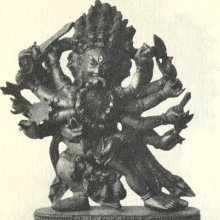Vajrakala, Vajrakāla, Vajra-kala: 1 definition
Introduction:
Vajrakala means something in Buddhism, Pali. If you want to know the exact meaning, history, etymology or English translation of this term then check out the descriptions on this page. Add your comment or reference to a book if you want to contribute to this summary article.
Images (photo gallery)
In Buddhism
Tibetan Buddhism (Vajrayana or tantric Buddhism)
Source: archive.org: The Indian Buddhist IconographyVajrakāla (वज्रकाल) is another name for Nīladaṇḍa: one of the ten deities of the quarters (Dikpāla) presiding over the Nairṛta-corner, commonly depicted in Buddhist Iconography, and mentioned in the 11th-century Niṣpannayogāvalī of Mahāpaṇḍita Abhayākara.—His Colour is blue; he has three faces and six arms.—The sixth deity in the series is Nīladaṇḍa who is the presiding deity of the Nairṛta corner.—In the vajrahūṃkāra-maṇḍala his name is Vajrakāla. But in the dharmadhātuvagīśvara-maṇḍala his name is Herukavajra.

Tibetan Buddhism includes schools such as Nyingma, Kadampa, Kagyu and Gelug. Their primary canon of literature is divided in two broad categories: The Kangyur, which consists of Buddha’s words, and the Tengyur, which includes commentaries from various sources. Esotericism and tantra techniques (vajrayāna) are collected indepently.
See also (Relevant definitions)
Full-text: Herukavajra, Niladanda.
Relevant text
No search results for Vajrakala, Vajrakāla, Vajra-kala, Vajra-kāla; (plurals include: Vajrakalas, Vajrakālas, kalas, kālas) in any book or story.
